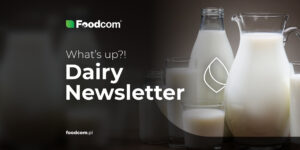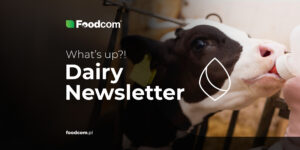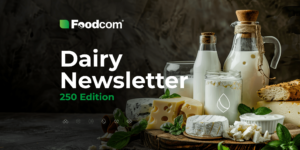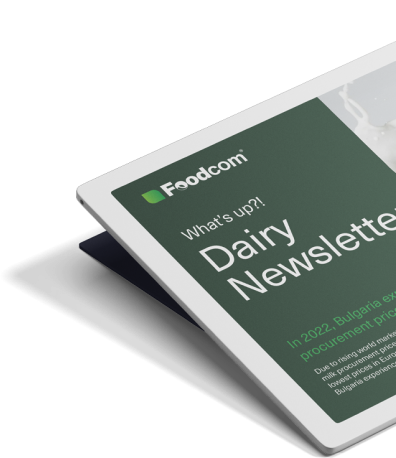- Stable SMP prices, although the upcoming increase in supply in Q2 may affect the market.
- Gouda and mozzarella prices supported by high retail and catering demand.
- Butter remains expensive and the market is waiting to see the impact of German retailers’ decisions on prices.
- Germany is battling an FMD outbreak and the Netherlands is facing a nitrogen emissions crisis – both challenges are redefining the regional agricultural market.
Welcome Partners!
Welcome back to our newsletter!
Let’s take a look at what’s been happening in the dairy market recently!
Milk powder
The market for skimmed milk powder (SMP) in Europe remains stable, with prices for fresh food grade SMP holding at 2550-2600 EUR/MT. There are currently no offers for cheaper products, indicating a strong market. Prices for bulk SMP for feed also remain stable at around 2450 EUR/MT for Q1 deliveries and slightly higher at 2470 EUR/MT in Q2.
Skimmed milk concentrate prices of German origin rose to 2050 EUR/MT FCA DE, driven by continued demand and limited availability.
The outlook for the SMP market remains stable, although cautious. Demand has stabilised after initial volatility in January, but a potential increase in milk supply in Q2 could affect prices. However, annual milk supply challenges and logistical constraints keep the market balanced, suggesting minimal price volatility in the short term.
Cheese
The cheese market in Europe has recovered from the volatility at the beginning of the year. Gouda prices remain stable at 4300 EUR/MT, supported by strong retail demand and continued consumption in EU countries. Mozzarella also remains stable, trading at 4100 EUR/MT. Although the market has calmed down, demand for mozzarella remains high, especially in the catering sector.
Cheddar prices have increased slightly to 4750 EUR/MT as low stock levels at some suppliers support positive market sentiment. However, the upcoming increase in milk supply may limit further increases. Emmental remains one of the most expensive cheeses in Europe at 5200 EUR/MT, driven by strong demand for a high cut product and limited interest in cheaper blocks.
The outlook for the cheese market is positive but moderate. Retail consumption supports price stability, although the seasonal increase in milk production may put downward pressure on prices later in Q2. The foot-and-mouth outbreak remains an issue to monitor, although its impact appears limited for now.
Fats
Butter prices in Europe remain high, in the 7300-7400 EUR/MT range. Retail demand has been weaker in recent weeks, but is now seeing a recovery. High production costs are limiting the flexibility of producers.
Cream prices showed high volatility, reaching as high as 8800 EUR/MT, before stabilising at 8600-8700 EUR/MT. The market is awaiting German retailers’ decisions on butter prices, which could affect price dynamics across Europe.
Anhydrous milk fat (AMF) prices have fallen slightly but remain high, in the 9200-9400 EUR/MT range. Export demand from the confectionery sector is a key factor supporting the market, while rising production costs are squeezing supplier margins. In the short term, butter and AMF prices should remain stable, although possible supply disruptions could lead to an increase.
Liquids
The cream market in Europe has stabilised after sharp increases at the beginning of the month. Prices currently stand at 8600-8700 EUR/MT, supported by strong demand in the confectionery and catering sectors. Seasonal increases in milk production have not significantly eased supply constraints, keeping upward pressure on prices. However, we expect slight decreases in the coming week.
Prices for concentrated skimmed milk (SMC) of German origin rose to 2050 EUR/MT FCA DE. Demand from processors remains stable, with logistical challenges limiting potential price reductions.
Spot milk prices remain stable at 560-600 EUR/MT, with slow growth in seasonal milk supply. The bluetongue outbreak has resulted in herd reductions in some EU regions, increasing supply concerns.
Whey powder
The whey powder market in Europe remains stable, with feed sweet whey (SWP) prices holding at 910-940 EUR/MT in Q1. Sweet whey concentrate (SWC) prices increased to 850-1000 EUR/MT FCA DE, recovering from earlier declines as fears of an FMD outbreak quietened. This recovery reflects stable demand from the feed sector and stabilisation of cheese production after initial disruptions.
Global factors also play an important role. Although the European whey market remains stable, increased capacity in the US may increase competition in export markets, particularly in Asia. The volatility of US cheddar prices affects the availability of whey protein concentrate (WPC), which may alter the global supply and demand balance.
The outlook for Q2 is for whey prices to be stable, although a seasonal increase in milk supply may put a slight downward pressure on prices. However, export demand, especially from Southeast Asia, may offset this effect, supporting the competitiveness of European producers. Possible disruptions in cheese production could lead to local whey shortages, affecting whey availability.
What else?
Europe
Germany launches emergency aid after a case of foot and mouth disease (FMD) is detected on 28 January 2025. The highly contagious virus threatens livestock health, prompting swift action, including quarantine, biosecurity measures and financial support for farmers. Agriculture Minister Cem Özdemir stressed the need to protect the food supply chain and called for vigilance across the sector.
Farmers affected by quarantine or culling will be compensated to mitigate losses. Germany is also coordinating with EU officials and veterinary experts to prevent further outbreaks. Neighbouring countries are closely monitoring the situation, highlighting the importance of regional cooperation in the fight against the disease.
The Netherlands is facing a worsening crisis of nitrogen emissions, with levels continuing to exceed environmental limits. Despite government efforts to reduce emissions, the problem persists, largely driven by intensive agricultural practices and industrial activities. This situation has led to growing tensions between policymakers and farmers, as stricter regulations are proposed to address the negative environmental impacts.
Experts warn that uncontrolled nitrogen emissions threaten biodiversity, soil quality and air health. The government is under pressure to balance environmental goals with protecting the agricultural sector, a cornerstone of the Dutch economy. As the debate intensifies, finding sustainable solutions remains a critical challenge for one of Europe’s most agriculturally dense countries.
South America
Brazil’s dairy industry is to receive €94 million in investment to boost production and improve market competitiveness. The funding, announced as part of a government initiative in collaboration with private stakeholders, will focus on improving infrastructure, modernising farms and raising milk quality standards. The move is expected to strengthen Brazil’s position as a major player in the global dairy market.
The investment also includes support for sustainable farming practices to balance increased production with environmental protection. Experts believe that this financial injection will boost innovation in the sector, benefiting both farmers and consumers. As global demand for dairy products increases, Brazil’s strategic push positions its industry for long-term growth and greater export opportunities.
![Strategic change in the dairy industry: a direction for the future [253rd Edition of the DAIRY Newsletter] Strategic change in the dairy industry: a direction for the future [253rd Edition of the DAIRY Newsletter]](https://foodcom.pl/wp-content/uploads/2023/08/Foodcom_Dairy_Newsletter-1520x760.jpg)






